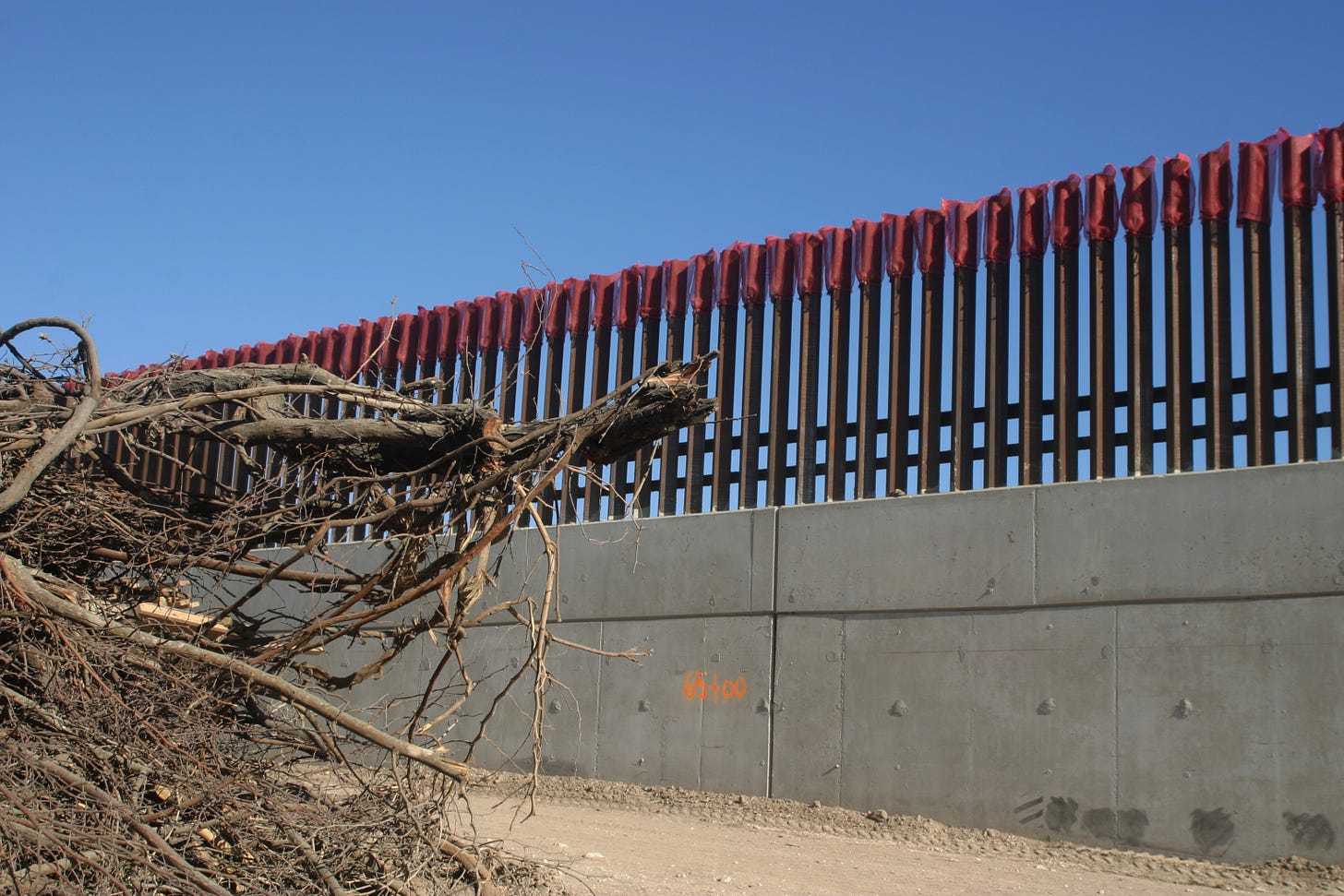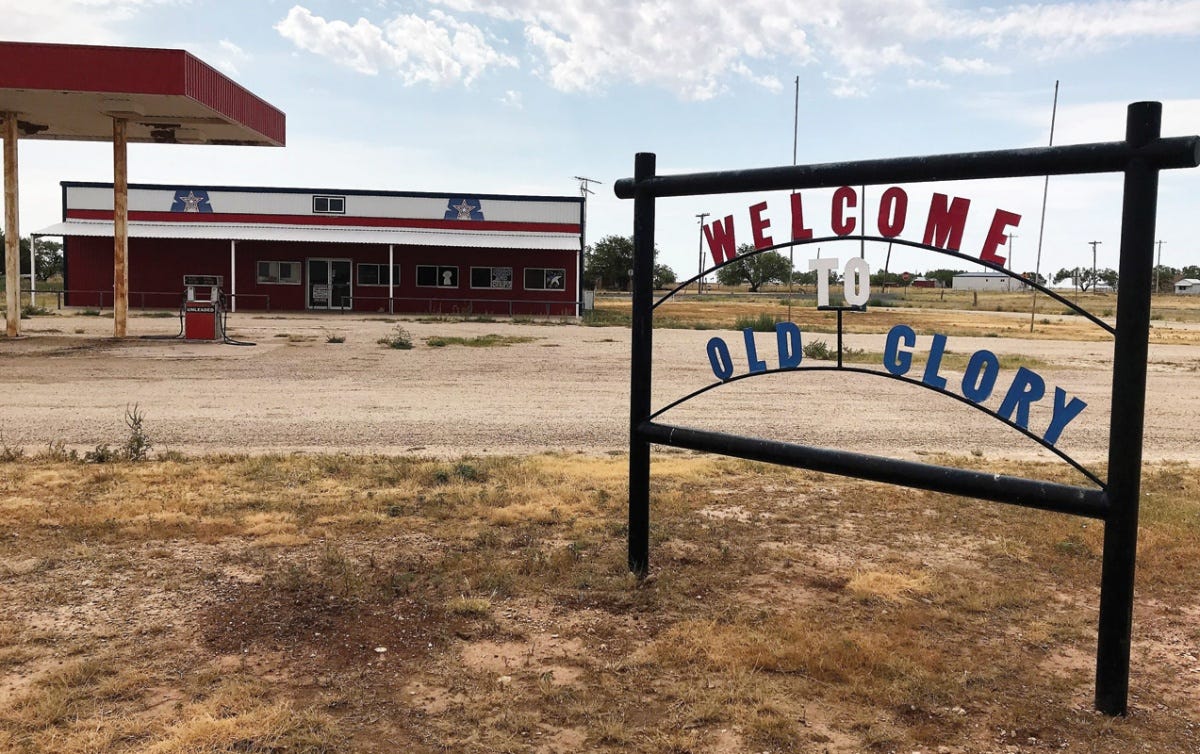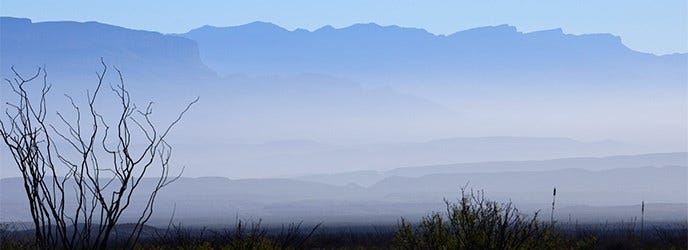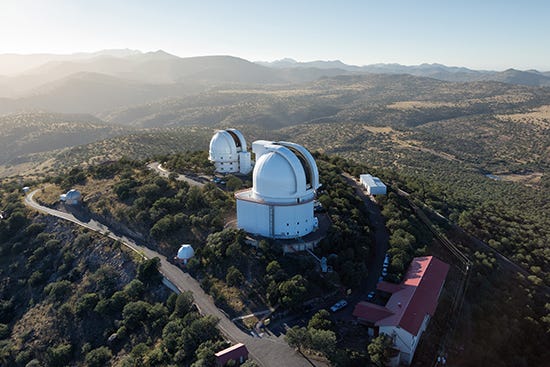(This newsletter is the rebirth of a project I started in 2017. My goal here is to offer information, insight, and maybe even entertainment. There will be personal experience included since I provide a point of view. But my focus is on this confounding state, its myths and realities. I will write about travel, literature, history, movies, politics, and just life its ownself under the Lone Star, and the broader influence of Texas beyond its borders.
It’s free to anyone who wants it, but those modest paid subscriptions, if you are inclined, can help fire the engines. Go ahead and be inclined. I’ll publish at least once a week, depending on interest, yours and mine. I will also post randomly with stories worth sharing and that are not part of the weekly newsletter).
“Texas is like Australia with the handbrake off.” – Tim Blair, Australian Diary
The Great Wall of Texas
I believe my abiding image of the Texas governor will forever be him staring and smiling at Donald Trump with the loving gaze of a lobotomized farm animal as the former president bragged about how he had gotten a perfect score on a cognitive exam. Trump was in Texas this past week to visit the border and look at the wall Mexico didn’t pay for and isn’t completed and is not currently under construction. He had come to the Rio Grande Valley at the request of Greg Abbott, who is using the plight of immigrants and landowners to launch his presidential campaign.
They began their little border bash with a news conference that had no news or reporters. Abbott and Trump were joined by the head of the Texas Department of Public Safety, indicted and FBI-investigated Attorney General Ken Paxton, book-censoring, and annoyingly ambitious Lt. Governor Dan Patrick and his hair, and the sheriffs of Tarrant and Brooks counties, neither of which are located on the border. As is the standard protocol with Abbott and Patrick, there were no journalists in the room, instead, simply a small collection of genuflecting public officials.
I was waiting for Trump to go around the room and ask each one of them to explain why they thought he was a great president.
Abbott was there to talk about how he is undermining civil rights and ignoring basic tenets of the state and U.S. constitutions with his plan for Texas to build a border wall to call its own, though he didn’t frame his comments that way; I did because it’s more accurate. Although state legislators did not appropriate a penny for tilting at windmills, Abbott made a down payment on his political fantasy by expropriating $250 million from the state’s Department of Criminal Justice, which he promises to pay back! Given the fact that each mile costs from $26 million to $46 million, depending on land prices, terrain, materials and engineering, the governor is going to have a gap of hundreds of miles on either side of his fence.
Sierra Club photo
His solution, unsurprisingly, was crowdfunding, like he was raising money for an app that would track low IQs so they could be contacted and urged to vote Republican. Actual humans have responded and there has been a cumulative total of $459,000 donated after two weeks. That should come in handy for building another 10 or 20 feet of barricade. Abbott says he wants a billion but he’s not going to get that from his goofy GoFundMyStupidWall campaign, he’ll have to find a way to misuse other public funds. Although he hasn’t let loose of a penny to help homeowners screwed with high utility bills because of the failed electrical grid during last winter’s storm, Abbott is believed to be lusting after Covid relief funds from Washington.
Democratic members of Congress from Texas sent a letter to U.S. Treasury Secretary Janet Yellen asking her to protect the state’s allocation of Covid funds from Abbott’s scheming. His strategy, though, is easy to predict. He will confiscate the cash and make the argument that building a Texas wall will keep out unvaccinated immigrants and that will help to stop the spread of the virus. Abbott and his minions might consider that this public funding approach didn’t work when it was tried in Arizona, and it sure as hell isn’t going to happen in Texas with a much longer and more rugged border.
In fact, every damned Republican knows states can’t afford to build something like the Great Wall of Texas. Simply bitching and trying to pull it off is what has been their primary focus. Keep the xenophobic crazies animated and ready to pull out their permitless carry pistols and stay angry till voting day, (assuming GOP controlled state governments don’t outlaw elections). Keeping crazies crazy has much to do with the motivation of Kristi Noem, the R governor of South Dakota, who has decided to send 50 members of her state’s National Guard down to help Texas protect its border. They are apparently good at keeping out North Dakotans. Noem accepted a million-dollar donation from an automotive junk yard billionaire from Nashville. Willis Johnson said he just wanted to help pay for the deployment.
Stars and Stripes
Noem and Johnson have raised many serious constitutional questions with this ploy. Is it legal for a wealthy political donor to hire taxpayer funded resources and personnel to affect his political vision? I am doubtful. I agree with Charlie Pierce of Esquire who suggested President Biden ought to immediately nationalize the South Dakota Guard and then order them to stand down and await further instructions from their commander at the Pentagon.
Let’s consider other possibilities. What if I live in a predominantly, upper class white community but there is a sudden influx of displaced African Americans who have decided they want to group their resources and set up an affordable place for them to live right next to my shining white stuccoed mansion? Doesn’t Noem’s precedent make it possible for me to fund the local cops to keep black folks away after I’ve accused them of crimes and potential future misbehaviors?
Yep, it does, if she gets away with this nonsense.
But that’s not stopping other states from pissing away their tax dollars on Texas. Florida’s Republican Governor Ron DeSantis equaled Noem’s move and is sending 50 of his state’s troopers down along the Rio Grande, and Nebraska and Tennessee, among others, are considering similar foolish gestures. That means there will now be an additional 100 cops looking for iHops from El Paso to Brownsville. What, precisely, does DeSantis think his 50 officers can do along the 1254-mile border that US Border Patrol and Customs cannot do, and who is going to pay for it? When he was asked that last question, he refused to answer because he said it might “jeopardize mission security.” Might also get Florida taxpayers jacked up because they are being overwhelmed with crime in their own state and don’t want to send police to Texas.
The theatrics are not always entertaining, and they are dangerous. Abbott has cleared out a state prison to incarcerate immigrants, though it’s unclear what state charges they might face. He just plans to toss them into a cell to await adjudication, which can’t happen unless they break a state law and Texas has no state law against crossing borders without proper paperwork. That is, elementary school civics students know, the business of the federal government, and, even if the feds are overwhelmed by the flow of troubled humanity, it does not give Texas or South Dakota or Tennessee or any other state the legal provenance to arrest and charge immigrants, unless they break a state law.
If you are a young lawyer, you might want to consider getting in on some of this action. Border counties are going to need lots of public defenders and pro bono work for all the people that will be processed and then cut loose because state law cannot detain them. Might be a good way to burnish your resume’ working for the ACLU or LULAC or one of the many rights groups protecting our constitution instead of hacking at it with instruments of ignorance.
How terrible the “border crisis” might be was called into question when the Texas governor declared it a disaster. The biggest counties on the border, which have the largest populations and most commerce with Mexico, opted not to cooperate with Abbott’s hysteria. County judges in Cameron, Hidalgo, Willacy, and Starr Counties asked to be removed from his legal document. Webb County, the location of Laredo, and El Paso County, also did not want to be pawns in Abbott’s presidential aspirations. Those counties probably include well over 90 percent of the border population, which means the governor is strictly posturing for political effect and serving the demands of a few ranchers on remote stretches of the Rio Grande.
This is all not completely without entertainment value. Watching Kristi Noem, Ron DeSantis, and Greg Abbott dance around each other in the presidential positioning game is humorous; especially when Trump is in town. The trio of Trumpers want to be the replacement choice should he choose not to run, or is physically unable, which is just as likely. There may not be much left of the Republican Party by the time Trump makes that decision, but you can be assured Noem, DeSantis, and Abbott will pick their way through the rubble to find survivors who might give them a vote. My sense is the Texan will not wait. DeSantis and Noem, and maybe even Nikki Haley, have time and might want to see how the party reconstructs itself, if the GOP can manage to pull that off before another generation passes away. Abbott, though, can be expected to position himself as the savior, assuming party leadership gets even more tainted by Trump worship.
When Donnie Dumbness was in the Rio Grande Valley this week, clogging highways with an overdone motorcade, he wasn’t concerned about much of anything other than talking about his great score on the cognitive test, being able to tell the difference between, man, person, woman, animal, and camera, and how the election was stolen from him. He mentioned the wall, but he is operating under the pathological delusion that it was built and is doing a great job. If it were, however, Abbott and he would be unable to whine about Biden creating a crisis, one which existed under Trump and has not been resolved by an incomplete wall, nor will it be. But that’s not Abbott’s goal.
Getting elected president is.
A Story of Old Glory
Even though we put her in the centerpiece of a TV news story, I regret that I do not remember her name, regardless of how many years have passed. I recall her face, though, and it was slightly puffy, and she had those narrowed eyes that come from living too long on the plains of West Texas and staring at distant horizons. The voice was nasal and almost liquid with no distinction between words, close to unforgettable. I think she had on a “Kenworth” gimme cap and her thick fingers were splayed across the counter next to the cash register.
She was being provoked for a TV production.
“But it’s just a piece of cloth with three colors,” she was told.
“Well, no, no it’s not,” she said. “It’s more ‘n ‘at, ‘n you know it.”
The screen door to her little store swung open and a bell tinkled softly before the wooden jamb sounded a slap.
“You don’t think you’re being sentimental? Even emotional about, you know, just an object?”
“Course I am.” She was almost indignant. “Ain’t you? You oughta be. I reckon we all oughta be.”
“Is that why you live out here? Because of the name and everything?”
“I live here ‘cause this is my home. I was raised up around here. But that name’s a good reason to be here and to stay.”
A customer approached the counter with a cold six-pack of beer and the provocateur stepped back to enable the transaction. Circles of sweat and dirt covered the back of the man’s shirt and his blue jeans had a brown sheen. After he paid, he looked at the lights and the camera and did a brief nod of recognition to the strangers but said nothing as he walked back out into the white summer Texas glare.
“You just think about it,” she continued. “Where it’s been and what it means. Who’s stood by it all the time, no matter what. Ever’body that died and that leadin’ up to you ‘n me standin’ here, free as we could be.”
“Sure. Sure. But when it comes down to it, it’s just a colored piece of cloth, isn’t it?”
She was frustrated, pulled back from the counter, and pointed her finger at the questioner.
“But that’s a precious thing,” she said. “And don’t you forget that. It’s a precious thing.”
She did not care that her little town was dying, the oil wells were going as dry as the cotton rows and the Oglala Aquifer beneath the soil, and the school was closed. There was a rusted harvester in a field across the road and a dry wind off the Chihuahuan Desert rattled a rope on the flagpole. There was no flag atop the pole, but the photographer turned around when he heard the screen door’s whack, and she was walking out with a carefully folded American flag.
The act was almost certainly performed daily but she moved with a look of grave responsibility on her face as though she had just been privileged to perform a sacred task. She gently opened the corners as if it were a living thing she did not wish to disturb and inserted clips from the rope into the two metal rings along the edge of the flag. She held it all above her head to protect it from the ground as she tugged the line with her free hand.
Nobody else was around to see her ritual, even though her town was named after the American flag. There was only the long line of sky and earth connecting in every direction, but she did not care about anything but her duty. Finally, using both hands to pull, she stared upwards as the wind caught the cloth and the flag snapped. Every day for years she had been raising Old Glory and it had only increased her reverence. She tied off the rope to the pole then turned and solemnly went back to her cash register.
Old Glory is the name of her hometown and it sits between the Salt Fork and the Double Mountain Fork of the Brazos River. German settlers founded the location as Brandenburg but there was never more than a schoolhouse and a general store and when a small railroad was built the town site shifted closer to the trains and became New Brandenburg. The anti-German fervor of World War I reached way out into West Texas and the people living in New Brandenburg decided to change their little town’s name to Old Glory. They wanted to prove their patriotism as immigrants.
There is not much to cheer about in Old Glory these days as farms fail and nearby oil wells get tapped out by time. The population is probably less than 100 and the young have left for the big cities of Abilene or Lubbock or Midland. The remainders of the past are all that is left to Old Glory, and those have faded in the sun and the years.
But there is that flag.
And when you hear politicians insulting each other with words and the democratic process with their behavior and their money, or you think about greed and corruption in business and on Wall Street, or riots caused by racial injustices, or giant political groups with hundreds of millions of dollars to distort your perceptions and judgments with their lies, or you consider wars lacking meaning or purpose, or schools without enough money or families without jobs and health care; just stop.
If only for a moment.
That is not what that flag represents. It is about what might be, what could be, what should be. It is an aspiration that is guaranteed, as you read this, to be fluttering on the wind in West Texas. Cynicism cannot even wound what it symbolizes. The founding promises have not exactly been kept but they still could be honored with our commitments and actions. That is what that flag represents. Possibilities for the evasive “more perfect union.” It still moves dreams and starts hearts. It always will.
That’s what makes a flag “a precious thing.”
The Air Out There
Across the international bridge at Eagle Pass, and about 10 miles to the Southwest of the Mexican City of Piedras Negras, two large smokestacks rise from the Rio Escondido. For more than three decades, they have been emitting hundreds of thousands of tons annually of sulfur dioxide, nitrogen oxide, and coal dust, into the air of Northern Mexico and the American Southwest. In fact, one study estimates the particulates amount to 230,000 tons of just sulfur dioxide a year sent aloft by the two electricity generators. During the summer months, the prevailing winds from the Southeast tend to drop most of the pollutants into the formerly pristine skies over Big Bend National Park.
The numbers, when I first heard them from a public official on the border, did not seem believable to me. Video journalist Kirk Swann and I went down to Mexico to record images of the electricity generating plant and conduct an interview with an official from the Mexican federal government. I confess to having been borderline angry about the fact that one of my favorite locales on the planet was enduring the pollution caused by the burning of low-grade lignite coal.
“Sir,” I asked, “Isn’t there anything Mexico can do to reduce the emissions?”
“Why, of course,” he answered. “We could put scrubbers on the stacks.”
“Is there a reason you don’t?”
“They are a half billion dollars each. Mexico does not have that kind of money.”
“Surely, the government has money to protect its environment and its citizens.”
“That’s what we are doing. We are giving them electricity.” I paused, my frustration readily apparent to the Mexican official. He smiled and continued.
“Your concerns are not our concerns,” he said. “You Americans are quaint. Blue skies and fresh air are so important. Do you know what matters here in Mexico to our people? We need electricity. To keep warm, to light our houses and our cities, cook our food. Make new businesses. We don’t have the luxury of worrying ourselves over sunsets like you do. If your government thinks that is so important, why don’t you just buy the scrubbers for us?”
I had no answer. The question was reasonable and logical, and the Carbon plants were not the only cause of air pollution at Big Bend National Park. The Department of Interior had charged park managers with determining sources of emissions that were hanging in the air at the remote spot. The monitoring and visual assessments often showed that the air quality there was worse than the Los Angeles basin. The National Park Service said that the Carbon generators, which are the two largest electrical power plants in Latin America, reduced visibility by 60-80 percent for about 8-11 months a year in Big Bend.
On rare clear days, an observer used to be able to look across the desert floor to the northwest from park headquarters at Panther Junction and see a white dot on a distant mountain top that was the McDonald Observatory, more than 100 miles away.
Those views have disappeared into the haze.
Big Bend National Park
The long-term monitoring of air quality in the Trans Pecos region has shown a manifest pollution problem that is compounded by air flow aloft and a simple matter of geographic location. During warmer seasons, southeasterly winds blow over the petrochemical refinery plants along the Gulf Coast and carry pollution inland to far West Texas, which then mixes with the pollutants from the Carbon electrical generating facilities. Winds shift in the fall and winter and particulates from Dallas pollution and Oklahoma oil refining are carried southward. Historically, there had also been particulates detected from coal-fired plants in Arizona and even some pollution from Los Angeles and El Paso. There is also the constant production of oil and gas in the nearby Permian Basin just to the north, which emits numerous air pollutants to endanger visibility year around, not the least of which is a vast amount of methane.
Rivers of air seem to converge over the Texas Trans Pecos and leave the refuse of modern life floating through the sky. The state, of course, has contributed to the problem by providing coal for the Carbon facilities in Mexico. An open pit mine in Maverick County, until last year, had a contract to deliver coal for the generators. Mexico cancelled the contract when it exceeded legal cost-of-production parameters, which was caused by a reduced demand for electricity and the expenditures required for the storage of unused coal. This slowdown, leading to a potential shutdown, was good news for air quality.
And then along came Texas.
In a counter-intuitive, doublethink announcement, state regulators at the Texas Commission on Environmental Quality (TCEQ) responded to a federal mandate to reduce haze in national parks and federally protected regions without placing new limits on pollutants. Possibly the largest creator of haze in Texas is the generation of electricity by coal power plants and they were not required by the state’s planners to install scrubbers or look for alternative sources of less polluting fuel.
The idea of pollution-reducing scrubbers technology, which came up in my interview almost thirty years ago, was seemingly never even discussed for Texas generators. TCEQ told the EPA that it only identified 18 power facilities that might have an impact on haze while the National Park Conservancy Association said there were at least 58 such generators. In submitting its plan to the National Park Service, the TCEQ wrote that it was unreasonable to require regulations for the reduction of haze “to a degree that is imperceptible to the human eye at the costs described.”
The Texas Do Nothing Plan will almost certainly end with environmental groups and probably the EPA suing the state to enforce the regulations, which has already happened in a previous standoff.
Meanwhile, up on Mount Locke at the location of McDonald Observatory, they look to the horizon for haze as much as they do the skies for stars. The observatory’s telescopes were placed in the Davis Mountains because the location had the least amount of light pollution of almost any place in North America, and the skies were crystalline. Increases in light are coming from Permian Basin oil and gas fields to the north, and the particulate haze is beginning to restrict views and nights of optimal observation of the stars.
But according to the Texas Commission on Environmental Quality, everything is just fine. Your eyes are deceiving you. Under the extreme right-wing conservatism of Texas’ government’s leadership since 1994, the TCEQ has been operating as more of a business facilitator than an agency to protect the environment. The loss of a distant horizon is hard to measure when you don’t know what you aren’t seeing, and like the compromising of our government institutions by conservative ideology, the failure creeps closer so slowly we won’t completely realize it until it is too late to save ourselves.












Another great edition. Keep em coming.